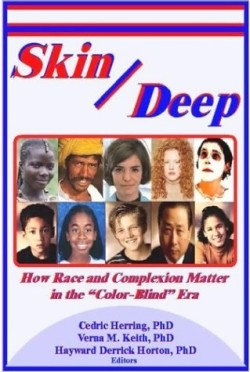
Skin Deep
How Race and Complexion Matter in the 'Color-Blind' Era
If beauty is in the eye of the beholder, then Americans’ standards of what’s desirable are only skin deep. That merging of clichés summarizes this collection of scholarly essays on skin color and its effect on societal norms in the Western Hemisphere, lending scientific weight to longstanding adages.
For those familiar with the shades of meaning implied-or, rather, perceived-in skin tones, the essays are bitter yet cogent reminders of how some things never change. Early on, University of Chicago professor Herring reminds the reader of the endurance of race and skin prejudice. “Skin color stratification is not a new phenomenon in the United States. Colorism in the U.S. dates back at least to the colonial era. For the most part, however, it has been overshadowed by or subsumed within more general issues of race and race relations.” Thus, while the civil rights struggle focused on the inequities of a racially stratified society, it did not prepare many for internal debate regarding skin tone within both the black community and larger society.
The essayists cite statistics to buttress their opinions that darker-skinned American blacks usually make less money, garner less material wealth, and otherwise lead lives more circumscribed than those of their lighter-skinned fellow blacks. Furthermore, the writers describe how issues of skin color are not just evident in black-white relations, but also inform interactions between blacks. For example, lighter-skinned blacks tend to marry those with same—or lighter-colored skin, unless they are marrying “up” to change their social status.
In an insightful bit of comparative history and sociology, essayist Vania Penha-Lopez describes race and skin color as it affects Brazilian society. In Brazil, she notes, the objective since slavery’s end has been to “whiten” society through intermarriage, thus making everyone the same color. Of course, however, such a drastic answer fails to take into account societal mores, issues of separatism, and other inevitable stumbling blocks. The result: A society in which darker skin tone is still associated with undesirability. Interestingly enough, however, Brazilians find a solution in money, which, as their wags say, “whitens” anyone.
The editors bring significant experience to the collection: Herring has written several studies on public policy and the black community; Keith, chair and associate professor of sociology at Arizona State University, has published studies of black mental health; and Horton, professor of sociology at the State University of New York at Albany, specializes in demography, race and ethnicity, and rural sociology. By applying the scientific method to what many still perceive as myths about color consciousness, these scholars go a long way toward providing an honest look at complex and often specious issues of race relations.
Reviewed by
James Abraham
Disclosure: This article is not an endorsement, but a review. The publisher of this book provided free copies of the book to have their book reviewed by a professional reviewer. No fee was paid by the publisher for this review. Foreword Reviews only recommends books that we love. Foreword Magazine, Inc. is disclosing this in accordance with the Federal Trade Commission’s 16 CFR, Part 255.
